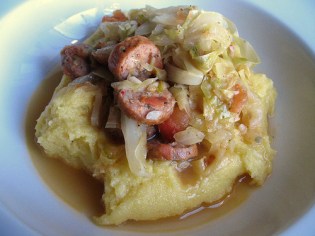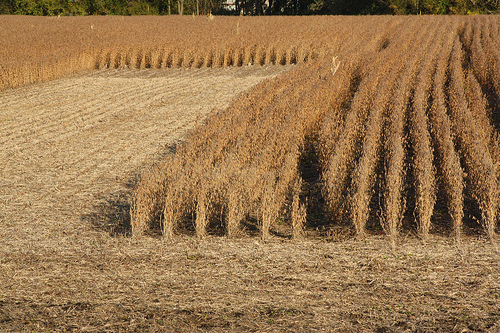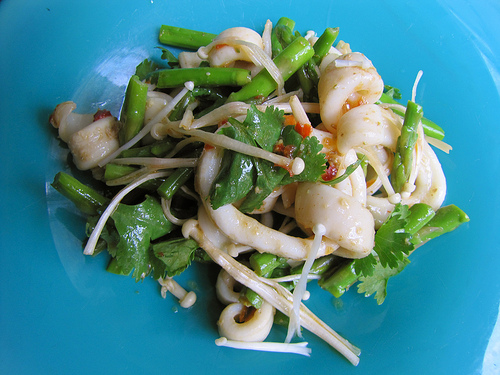This post is part of Protein Angst, a series on the environmental and nutritional complexities of high-protein foods. Our goal is to publish a range of perspectives on these very heated topics. Add your feedback and story suggestions here.
“I am in burger heaven!” exclaimed a friend of mine who, after six years of being a strict vegetarian, had recently moved away from the diet. It was the end of an era for her, and her taste buds could no longer remember what a juicy patty made with good ground beef tasted like. Hallelujah.
She never went back to being a full-time meat eater, and maybe that’s why to this day she retains a similar sense of awe when encountering any dish made with meat. A reentry into the world of meat-eating after a long withdrawal can be stimulating, even spiritual, some say. On a less-intense level, eating meat in small doses — around once a week — gives me a deep sense of appreciation for it, too. I doubt this would be the case if my palate were weakened by its constant presence in my meals. Absence makes the taste buds grow fonder.
Studies have been showing that Americans are eating less and less meat today, and while there are differing takes on why this might be, there is a growing indifference about the necessity of meat on every plate. This is surely good news for the environment. But what about the average household? Maybe they’re also rediscovering a simple rule: We appreciate meat more when we can’t have it all the time.
This wouldn’t exactly be the case if we were talking about an abstinence from, say, potatoes, or peanuts, either. Animal protein holds a special place as a food substance, and while scientists may argue about how necessary it may be for human consumption, few chefs can argue against its value as flavor enhancer. Animal flesh is an extremely complex web of compounds shaped by all the simpler compounds consumed by the animal, too. Its flavors will range, but it’s commonly served to make bland foods more appealing.
Aside from a purely sensory appreciation, there are several pluses to indulging in small quantities of meat. It’s a great way to explore flavors, expand your horizons, and, hopefully, become better at creating vegetarian versions of dishes that have been traditionally built around meat (Cassoulet and Jamaican patties are some recent examples in my kitchen). I also enjoy meat on occasion because it brings me closer to people who raise livestock and that aspect of tending to the land. It can be downright impossible to understand what’s behind highly processed foods, but at least I can take in meat and understand all steps that went into its production — that’s rewarding when I sit down to eat. Finally, buying meat from those producing it through responsible and humane practices means I can afford much less of it.
We have a lot to learn from our meat-strapped ancestors, who knew many ways to use a little bit of this magical flavoring agent in foods to stretch flavor. When we reverse the mainstream American approach to meat — from main dish to a seasoning for larger portions of vegetables, legumes, and grains — the gastronomic possibilities are endless. In fact, in many of the world’s cuisines, it can be difficult to find vegetable-based foods that are not flavored by small amounts of animal protein. Fish sauce is an intrinsic seasoning in much of Southeast Asian fare, a ham bone is deemed essential to a good pot of split pea soup in the States, and many Koreans can’t fathom making kimchi without oysters or anchovies.
I’ve been practicing cooking with less meat for years — and have featured quite a few recipes on my blog Not Eating Out in New York. Below you’ll find some of my favorite examples:

Photos by Cathy Erway.
Spicy Squash and Chorizo Soup
(serves about six)
1 medium butternut squash, peeled, seeds and pulp removed, and cut to 1-inch cubes
2-3 chorizo links, finely diced (substitute with tempeh or tofu sausage for a vegetarian version)
1 large Spanish onion, diced
1 bell pepper (any color) diced
5 cloves garlic, minced
2 ancho chiles (dried poblano peppers), stemmed, seeded and torn to smaller pieces
4 cups chicken or vegetable stock
1 tablespoon tomato paste
1 bunch cilantro, about half of it finely chopped and the rest for garnish
1-2 teaspoons ground cumin (toasted and freshly ground from whole seeds is best)
1 teaspoon ground coriander (toasted and freshly ground from whole seeds is best)
1/4 teaspoon cayenne pepper
1 tablespoon cornmeal (optional)
Fresh lime juice to taste
1-2 tablespoons olive oil
Salt and pepper to taste
Crema (or sour cream) for garnish
Optional: thinly sliced red onion and tomato wedge for garnish
Place the ancho chiles in a small saucepan and fill with enough water to cover. Bring to a boil, cover, and let sit for 20 minutes. Transfer to a food processor or blender and pulverize until smooth.
In a medium-large heavy-bottomed pot, brown the diced chorizo while stirring over medium-high flame for five to seven minutes. Set aside; in the same pan, sweat the onions, peppers, and squash cubes in the remaining chorizo grease and the additional olive oil. Season with salt, pepper, cumin, coriander, and cayenne. Stir frequently while cooking for eight to 10 minutes. Add the garlic and tomato paste and stir another minute. Return the chorizo to the pot and add the ancho puree, stock, and chopped cilantro and bring to a boil, and reduce heat to a simmer. Cover and let cook for 20-30 minutes.
Taste stew for seasoning, adding more of anything, and cook off enough liquid to desired consistency (or add more stock if necessary). Add fresh lime juice. Once flavor is correct, add cornmeal to thicken, if desired. Serve in individual bowls and top with a squirt of the crema, red onions and/or tomato wedge, and remaining cilantro leaves for garnish.
 Sunchoke Salad with Bacon & Scallions
Sunchoke Salad with Bacon & Scallions
(makes four to six servings)
1 lb. sunchokes (or Jerusalem artichokes), scrubbed and sliced to 1/4-1/2 inch rounds
2-3 scallions, both white and green parts, thinly sliced
About 1/8 lb. bacon, cut to thin strips
1/3 cup white vinegar
1 tablespoon mustard (preferably whole-grain)
Salt and black pepper to taste
Extra-virgin olive oil
Preheat oven to 375 degrees. Scatter sunchoke pieces on a roasting pan and toss with a thin coat of olive oil and a couple pinches of salt and pepper. Roast for three to five minutes; check to see if the bottoms are golden-brown and toss them around in the pan if so. Roast another three to five minutes and remove from heat.
Meanwhile, cook the bacon strips in a large, wide pan until lightly browned, stirring occasionally. Remove from heat. In a separate bowl, combine the vinegar, mustard, and a few pinches of salt and pepper. Toss the roasted sunchokes in the pan with the bacon and pour in the vinegar mixture. Stir well to distribute evenly and season with salt and pepper to taste. Toss in the scallions. Cover and refrigerate for at least 20 minutes or up to overnight.
 Asparagus & Squid with Ponzu-Chili-Lime Vinaigrette
Asparagus & Squid with Ponzu-Chili-Lime Vinaigrette
(makes four to six salad-sized servings)
1 lb. cleaned squid
1/8 teaspoon ground cumin
1/8 teaspoon salt
1/8 teaspoon freshly ground black pepper
1 tablespoon vegetable or canola oil
1 lb. fresh asparagus, tough ends trimmed
1/2 bunch fresh enoki mushrooms, ends trimmed
1/4 bunch fresh cilantro leaves (stems trimmed)
1 tablespoon Japanese Ponzu (a citrus-seasoned soy sauce)
1 tablespoon fresh lime juice
2-3 teaspoons sesame oil
1 teaspoon sambal olek, or chili-garlic sauce
Heat a pot of water and prepare an ice bath. Cut trimmed asparagus into 1-2 inch logs. Blanch for one minute and transfer immediately to ice bath to cool and preserve color. Once cold, drain.
Cut the tentacles from the cleaned squid and remove bodies of any remaining guts. Cut about half of the squid bodies into 1/4 inch rings (like fried calamari), and slit the remaining half of the squid bodies lengthwise. Cut those squid bodies lengthwise into 1/4 inch strips (or “noodles,” as my co-chef called them). This will provide for a variety of shapes once they sizzle in a pan.
Mix the raw squid with the salt, pepper and cumin in a small bowl. Heat the vegetable or canola oil in a fry pan and once it’s very hot, add the squid. Stir-fry until just opaque rather than milky-clear, about one minute or under. Transfer to a clean bowl. In another small bowl, combine the ponzu, lime juice, and chili-garlic salt and adjust any ingredients to taste. Toss both the drained asparagus and squid in the dressing and toss in the cilantro leaves and enoki mushrooms towards the end. Serve immediately at room temperature or chill combined first if desired.
 Braised Cabbage and Sausage with Polenta
Braised Cabbage and Sausage with Polenta
(makes two servings)
About 2 cups cabbage, shredded
1 spicy chicken sausage link (or any sausage you prefer), sliced
1 large clove garlic, minced
1 handful celery leaves, chopped
1 small-medium plum tomato, chopped
1/2 cup fine yellow cornmeal
1 tablespoon extra-virgin olive oil
Salt and pepper to taste
In a skillet or wide saucepan with a lid, heat the olive oil on medium-high. Add the garlic and celery leaves, and stir for about five seconds. Add the sausages and stir until cooked, about two minutes. Add the cabbage and tomato and cook, stirring occasionally, until the cabbage is translucent, about three to four minutes. Season with a few pinches of salt and pepper. Add one cup of water, reduce heat to low and cover.
Meanwhile, bring 2 1/4 cups water to boil in a saucepan. Reduce heat to medium, and pour in the cornmeal while whisking rapidly. Keep whisking, and in about 10 seconds you should have polenta. But to continue softening the grains for a more refined and creamy polenta, keep cooking on low heat, adding water, and whisking frequently. Season with a little salt to taste.
Lift cover from pan after about five minutes of cooking. Continue cooking excess liquid off for another five minutes or so, or until consistency is just slightly soupy. Taste for seasoning, adding more salt or pepper as desired. Serve on top of a scoop of polenta.
 Turkey & Quinoa Soup with Bitter Greens
Turkey & Quinoa Soup with Bitter Greens
(for eight to 10 servings)
To make the stock:
One 10-12-lb. turkey carcass and stray bones
1 onion, chopped in half with the peel
1 carrot, roughly chopped
1-2 stalks celery with the leaves, roughly chopped
2 tablespoons extra-virgin olive oil
Salt and freshly ground black pepper to taste
For the soup:
1 onion, chopped
1 carrot, chopped
1-2 stalks celery with the leaves, chopped
3 cloves garlic, minced
1 bunch mustard greens, stems trimmed and chopped
1/2 bunch or so of arugula
8 cups homemade turkey stock
1 cup turkey meat, picked from the carcass
2 bay leaves
1/2 cup dry quinoa (red or white are both fine)
Pick the meat from the turkey carcass and reserve. To make the stock, combine the turkey carcass with the vegetables and cover with water in a stockpot. Bring to a boil, reduce heat to a simmer and cook, uncovered, at least two hours or up to four, turning the carcass over once or twice in between.
In a large, heavy-bottomed pot or Dutch oven, heat the oil and add the onion, carrot, and celery. Season with a generous pinch of salt and cook over medium heat, stirring occasionally, until onions are translucent, about eight minutes. Add the garlic and cook, stirring occasionally, another two minutes. Add the bay leaves, picked-apart turkey meat, and the stock and bring to a boil. Reduce to a simmer and cook, covered, for 30 minutes to one hour. Add the mustard greens and arugula and stir in until wilted. Continue to cook, covered, for 30 minutes to one hour. Add the quinoa and cook for five to 10 minutes longer. Taste for seasoning, adding salt and pepper as desired.



